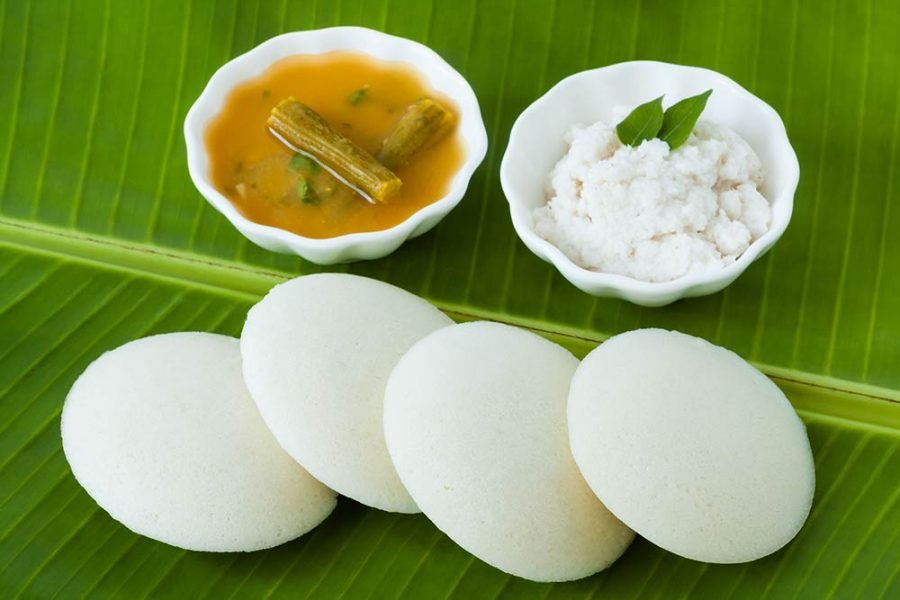The Heartbeat of South Indian Cuisine
Some dishes don’t just feed the stomach—they feed the soul. And for most South Indians, Idli Sambar is that dish. It’s what many of us grew up eating for breakfast on quiet weekday mornings, or as a weekend brunch when the whole family gathered at the table, still in pajamas. It’s soft, fluffy, spongy idlis—made from a beautifully fermented batter—soaking up the piping hot, tangy, and hearty sambar. Add a spoonful of coconut chutney on the side and you’ve got a meal that’s as simple as it is divine.
Let me take you through the full process of making Idli Sambar just like we do at home in South India. It’s not instant food, and it doesn’t come from a packet. It’s made with love, patience, and everyday ingredients that magically come together to create something memorable.
Part One: Idli – Soft Steamed Rice Cakes
Before we make the sambar, we’ll prepare the idli batter—because this part takes time. The secret to soft idlis is in soaking, grinding, and fermenting the batter well.
Ingredients for Idli Batter (makes about 20 idlis):
- 2 cups idli rice (or parboiled rice)
- ½ cup urad dal (whole white lentils)
- 1 tablespoon fenugreek seeds (methi)
- Salt, to taste
- Water, as needed
Step 1: Soak the Ingredients
Start in the morning if you want to ferment overnight. Wash the rice in a large bowl until the water runs clear. Soak the rice with enough water to cover it.
In another bowl, rinse and soak the urad dal and methi seeds together.
Let both bowls sit for at least 6 hours. If you’re soaking overnight, that works too. Methi seeds help in fermentation and also make the idlis softer.
Step 2: Grind the Batter
After soaking, first grind the urad dal and methi with a little water until the batter is light, fluffy, and smooth. You’ll know it’s right when it’s almost like soft whipped cream.
Then grind the rice separately—it should be slightly coarse, like fine semolina (rava).
Now mix both together in a big bowl or vessel. Use your hand to mix, not a spoon—this is how my mom taught me. Your hand naturally adds warmth and wild yeast that helps the batter ferment beautifully.
The batter should be thick but pourable—like thick pancake batter.
Step 3: Ferment the Batter
Now cover the bowl and leave it in a warm place overnight (around 8–12 hours). In the morning, it should have risen and look bubbly and slightly sour.
If it’s cold where you live, leave the bowl in the oven with the light on or cover it with a thick towel and place it near a warm corner.
Once fermented, gently stir in the salt. Don’t overmix—you don’t want to disturb all those beautiful air pockets.
Step 4: Steam the Idlis
You’ll need an idli steamer or pressure cooker with idli plates.
- Grease the idli molds with a little oil.
- Pour in the batter, filling each mold about ¾ full.
- Steam for 10–12 minutes on medium heat.
- Don’t use the whistle if you’re using a pressure cooker.
- Check doneness with a toothpick—if it comes out clean, they’re ready.
Let them rest for 2 minutes, then use a spoon or butter knife to gently lift them out.
Cover with a clean kitchen towel to keep them warm and soft.
Part Two: Sambar – The Soul of the Dish
Sambar is warm, hearty, and full of flavor. It’s made with toor dal (pigeon peas), tamarind, vegetables, and a spice blend that varies slightly from home to home. What makes it truly South Indian is the tempering—or “tadka”—added at the end. Trust me, it’s the finishing touch that makes everything come alive.
Ingredients for Sambar:
- ½ cup toor dal (pigeon peas)
- 1 small onion or 6–8 shallots (sambar onions, if available)
- 1 medium tomato, chopped
- 1 carrot, chopped
- 1 drumstick (vegetable, not the gym kind), cut into pieces
- ¼ tsp turmeric powder
- Salt, to taste
- 1 lemon-sized ball of tamarind (or 1 tbsp tamarind paste)
- 1–2 tsp jaggery (optional but recommended)
For Tempering (Tadka):
- 2 tsp coconut or sesame oil
- 1 tsp mustard seeds
- ½ tsp cumin seeds
- 2 dried red chilies
- A pinch of asafoetida (hing)
- 10–12 curry leaves
For Homemade Sambar Powder (optional but makes a difference!):
Dry roast the following and grind them into a coarse powder:
- 1½ tbsp coriander seeds
- 1 tsp chana dal
- 1 tsp urad dal
- ½ tsp fenugreek seeds
- 3–4 dried red chilies
- ½ tsp cumin seeds
- Few curry leaves
Store this in a jar. It smells incredible and lasts for weeks.
Let’s Make the Sambar
Step 1: Cook the Dal
Wash the toor dal and pressure cook it with 2 cups of water, a pinch of turmeric, and a few drops of oil (this keeps the frothing down). Cook for about 4–5 whistles or until completely soft.
Mash the cooked dal with a spoon or whisk and set aside.
Step 2: Cook the Veggies
In a deep pan, add chopped onions, tomatoes, carrots, and drumstick. Add just enough water to cover the vegetables, some turmeric, and salt.
Let this simmer until the vegetables are soft but not mushy—about 10 minutes.
Step 3: Add Tamarind and Sambar Powder
Soak the tamarind in warm water for 10 minutes, then squeeze and strain it. Add this tamarind extract to the vegetables.
Add 1 to 2 teaspoons of your sambar powder and some jaggery. Stir well and let everything simmer for 5–7 minutes.
Step 4: Add the Cooked Dal
Now pour the mashed dal into the tamarind-veggie mixture. Mix everything well and adjust salt if needed.
Add water as required to get your preferred consistency. Sambar should be pourable—not too thick or watery.
Let it gently simmer for another 5–6 minutes so all the flavors come together.
Step 5: Tempering (Tadka)
This is the most aromatic part of the dish!
Heat oil in a small pan. Add mustard seeds and let them splutter. Add cumin, red chilies, curry leaves, and a pinch of hing.
Immediately pour this over the hot sambar. You’ll hear a sizzle and your kitchen will fill with the scent of South Indian magic.
Let the sambar rest for 10 minutes. It always tastes better after a short rest.
How to Serve
Take two or three hot idlis and place them on a plate. Pour generous ladles of steaming sambar over the idlis. Let them soak up the flavors.
Add a side of coconut chutney if you have it, or even a small spoon of ghee on top for richness.
Some like to break the idlis with their fingers and dip each piece in sambar, while others prefer drenching the whole plate. No wrong way here—just deliciousness.
Tips from a South Indian Kitchen
- Use whole urad dal for better fermentation and fluffier idlis.
- Drumstick (the veggie) adds a special aroma to sambar. If you can get it, don’t skip it.
- Let your batter ferment naturally—never add baking soda or shortcuts unless absolutely necessary.
- Sambar tastes better the next day—just like curry!
- Coconut oil or sesame oil makes the best tadka for authentic flavor.
Final Thoughts
There’s a reason Idli Sambar isn’t just eaten in the south but loved all over India. It’s humble, nourishing, and rooted in tradition. Whether you’re in Chennai or Delhi, a plate of soft idlis soaked in sambar feels like a warm hug.
And once you make it at home—even once—you’ll realize how easy and rewarding it really is. The batter becomes part of your weekly routine, the sambar evolves with the veggies you have, and the aroma becomes part of your mornings.
So the next time you want a truly soulful breakfast or a light but satisfying dinner, skip the packaged stuff. Make a batch of fresh batter, simmer some sambar, and serve up a dish that’s been passed from grandmother to mother to child for generations.
Welcome to the South Indian way of life—one idli at a time.

